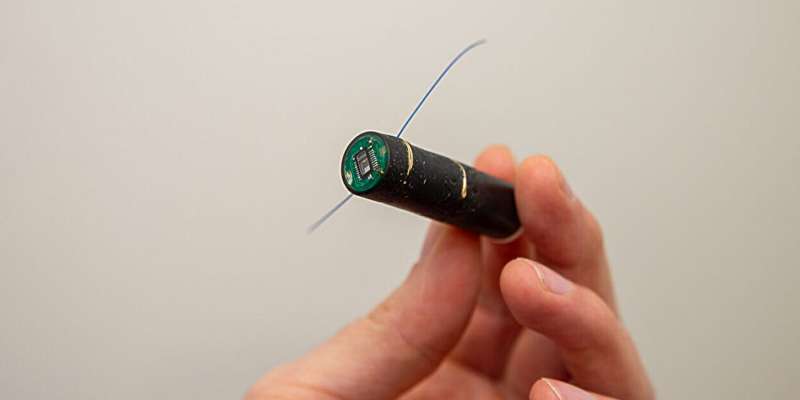This article has been reviewed according to Science X's editorial process and policies. Editors have highlighted the following attributes while ensuring the content's credibility:
fact-checked
trusted source
proofread
Sensor implant gathers information about the welfare of individual farmed salmon

Sick and injured farmed salmon are a problem, but researchers have recently developed an implant that uses sensors to gather information about the welfare of individual fish.
"Fish welfare must be improved. To achieve this, fish farms need information about the welfare of the salmon they are raising. Currently, however, we have very few methods for investigating the health of individual fish."
So says research scientist Eirik Svendsen at SINTEF Ocean. He and his colleagues are now working to develop technologies that will provide us with new knowledge about the welfare of farmed fish.
Fish welfare is a relevant issue
We already have a lot of technological tools that can help us to observe and gather data about fish behavior in net pens. This is what researchers call behavior at population and group level.
"We need a higher resolution on the welfare scale so that good welfare is not simply alive and bad welfare is dead."
There are many issues the industry needs to look into, such as; how are the health, growth and welfare of individual fish influenced by different factors in their immediate environment? What is the influence of the design of a fish farm facility? And what about the placement of individual net pens within the overall facility design?
SINTEF is looking into these factors as part of a project called RACE Welfare. Provisional results indicate that fish farm design does exert a major impact on fish behavior. This is probably because it influences the level of exposure of the fish in individual net pens to prevailing waves and currents.
"It will be interesting to monitor and compare several individual fish in net pens within a given facility under the highest and lowest levels of exposure, respectively," says Svendsen's colleague Pascal Klebert, who also works at SINTEF.
However, to be able to interpret observations from a given population, researchers must examine the behavior of individual fish under a diversity of different conditions.
"In practice, we need to gather a 'forest' of data on the various aspects of fish behavior before we can identify the 'trees'—the things we really want to know," says Svendsen.
Advanced implant offers new opportunities
It is this data gathering the new implant in our headline will be used for. It is designed to acquire larger volumes of data than any other existing system—and all of it simultaneously.
Moreover, the fish don't have to carry several different sensors in their abdominal cavities. The implant is cylindrical—just 47 mm long with a diameter of 13 mm. It contains a battery, a memory card and a microcontroller, and is fitted with measuring devices for gathering data on blood oxygen content, heart rate, levels of activity, directional orientation and temperature.
"It hasn't previously been possible to gather all these types of data simultaneously," says Svendsen. "The implant offers us entirely new opportunities to address the requirements that new methods designed to improve fish welfare must be tested before they are used in practice," he says.
"We need a higher resolution on the welfare scale so that good welfare is not simply alive and bad welfare is dead," says Svendsen.
He envisages a future system whereby a selected group of so-called "sentinel" fish, fitted with implants, will be introduced to each net pen in a given facility. The sensors in the implants will gather data that will be used to determine a "welfare score."
"It will not necessarily always be appropriate simply to use a single, precise score," says Svendsen. "However, based on our existing knowledge, an acceptable score can be defined as a threshold value. When the microcontroller in the implant analyzes the data, it will send a message if the score falls below the acceptable welfare threshold. This will give fish farm operators clear notification to start investigating for causes and implementing measures in the net pen where the poor score is recorded.
Can we find out if a fish is being inconvenienced by the implant? "What we know is that so-called 'welfare-related indicators' such as heart rate and swimming activity become normalized after a given period following insertion of the implant," says Svendsen. "On this basis we can assume that a fish has recovered and is not being inconvenienced to any great extent by the implant. However, complications such as infections may arise, so this is a complex issue," he says.
"It's also important to employ fish that are large enough to accommodate an implant and, at the same time, implants that are as small as possible. Fish should also be allowed time to recover after insertion," says Svendsen. "This is important because it will minimize any negative impacts that may bias the results," he adds.
Real world application
The first new task for the researchers is to improve the design of the implant, which has been developed as part of the project Salmon Insight.
"The next stage is a project called RACE TAG," says Svendsen. "Here, we'll be conducting thorough tests on fish in swim tunnels, combined with data acquisition in net pens. It's important to us that the new measurement approaches are applicable at full-scale in fish farms under operational conditions. We can do a lot of clever stuff in the lab but, in this project, we want to measure the links between physiology and behavior in the real world where farmed fish actually live," he says.
Provided by Norwegian University of Science and Technology





















